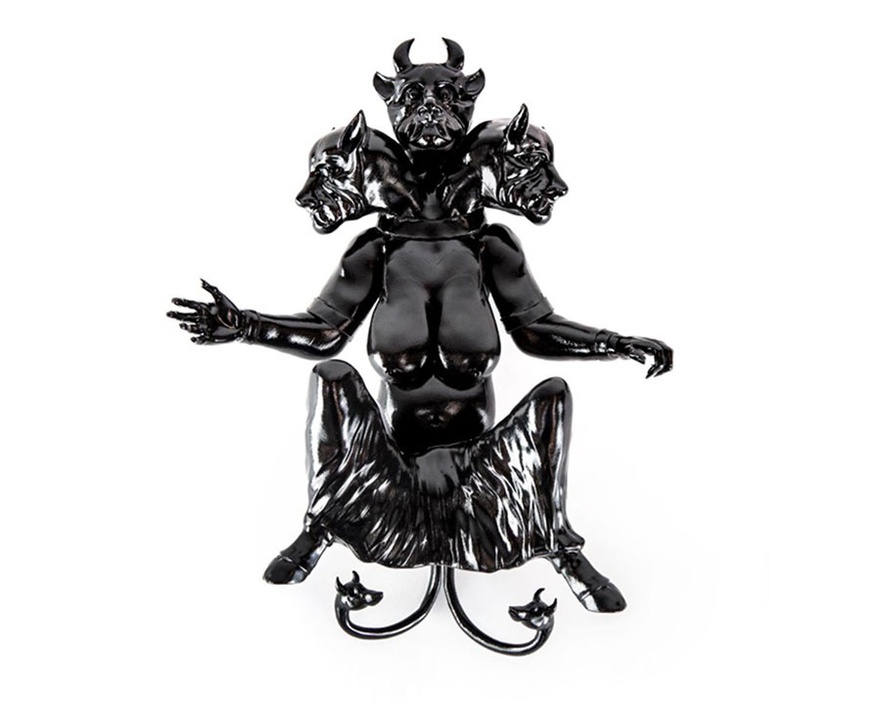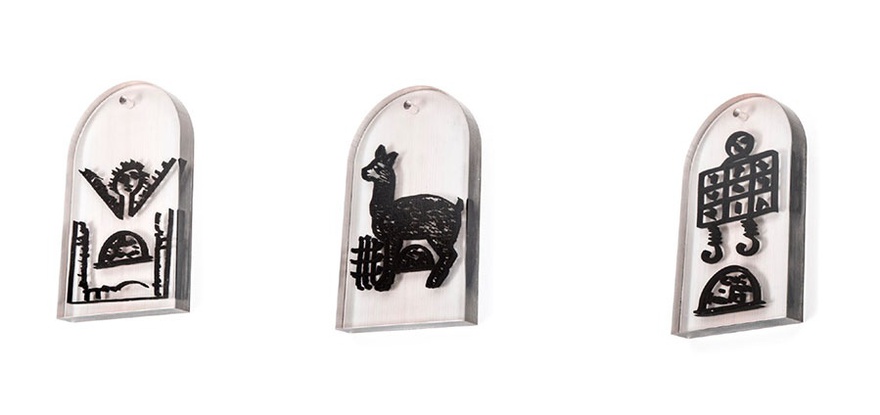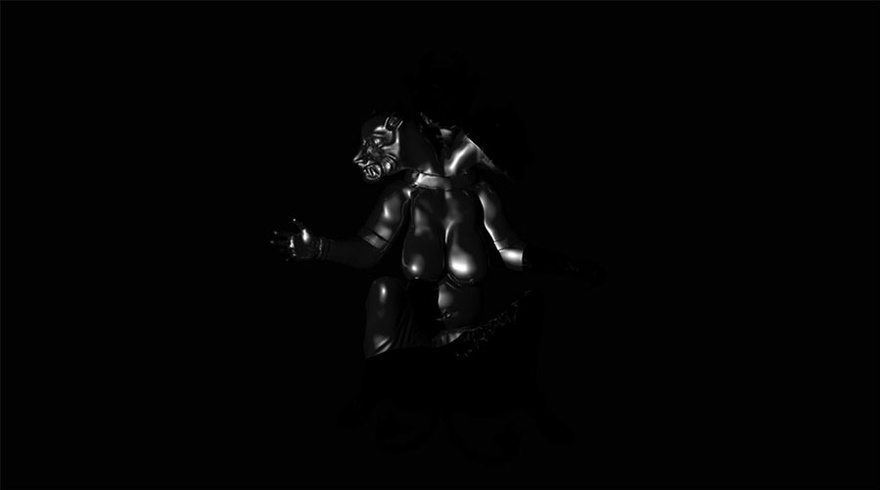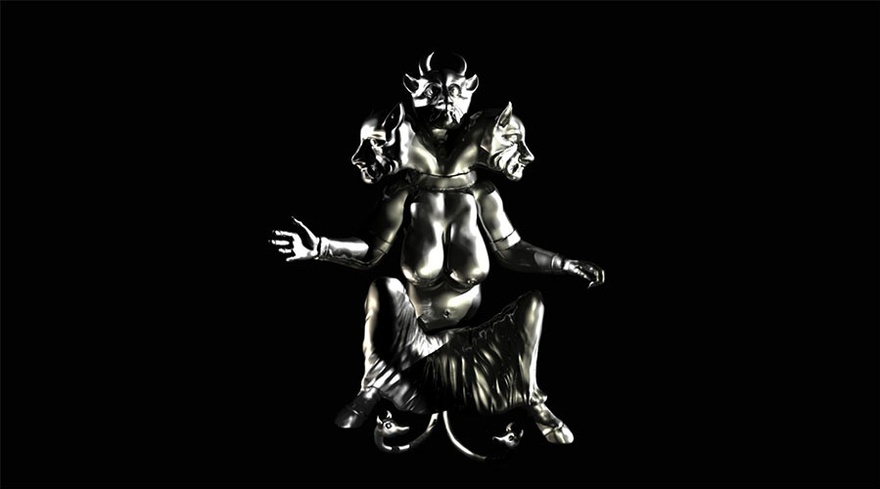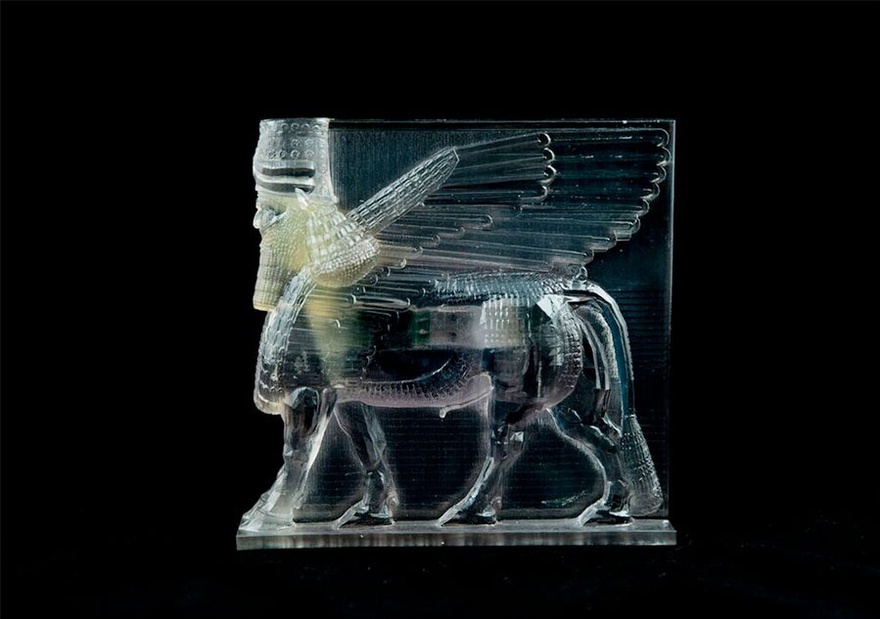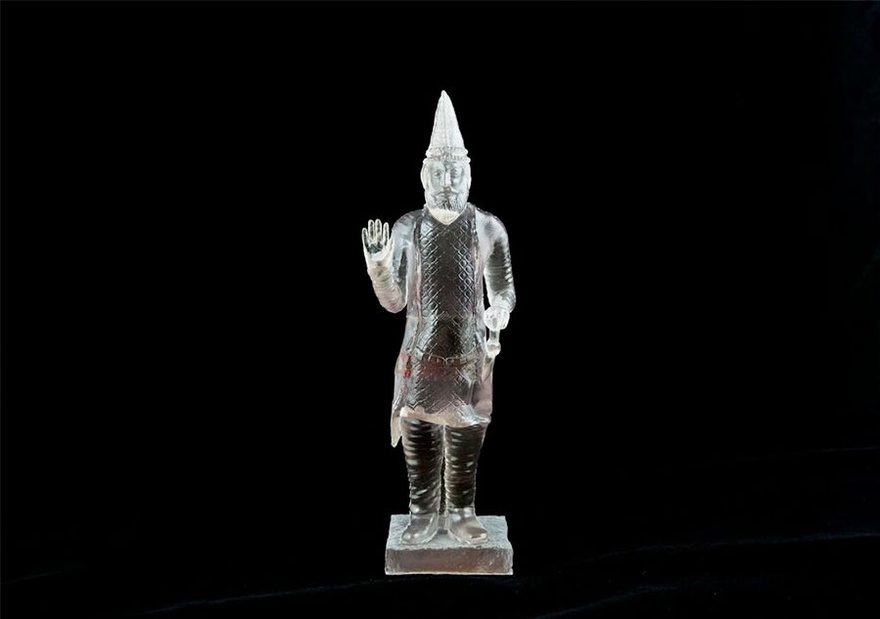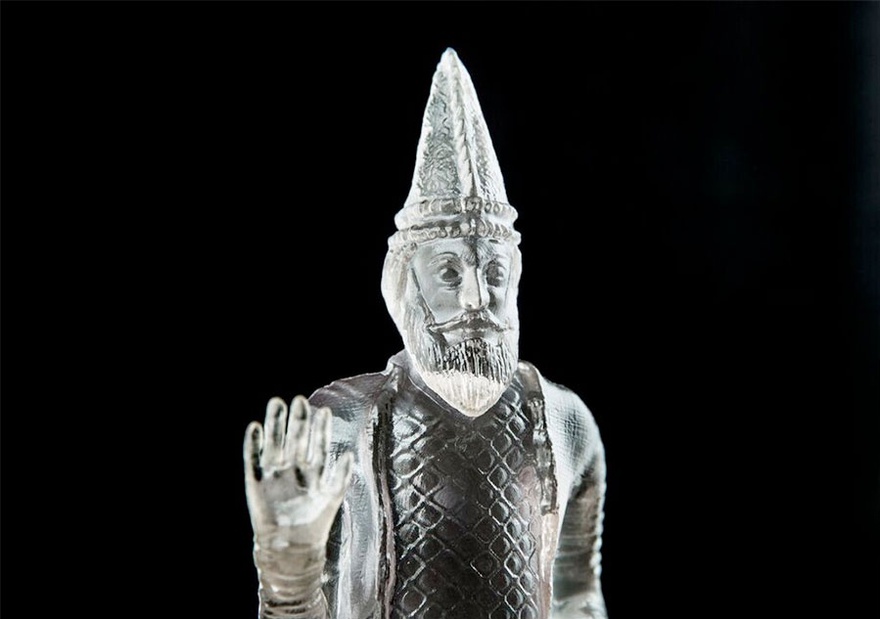Interviews
Dark Matters
Morehshin Allahyari in conversation with Hannah Gregory
Morehshin Allahyari left Iran in 2007 to pursue a critical artistic practice, choosing, in her words, 'self-exile over self-censorship'. Her work holds technology as 'a philosophical toolset' and 3D printing as a potential 'process for repairing history and memory', levelling equal criticisms at both the oppression of religious dictatorship and the white-privileging worldviews of the technology and art industries. Dark Matter (2012–14) was her first experiment with additive tech as political medium, in which Allahyari turned taboos of Iranian daily life – dogs, pigs, satellite dishes, and dildos – into absurdist 3D-printed amalgams. The widely acclaimed Material Speculation: ISIS series (2015–16) pieced together the histories of artefacts destroyed by the Islamic State in the ancient cities of Hatra and Nineveh, through in-depth research and correspondence with archaeologists, historians, and museum staff. The reconstructed replicas, printed in translucent resin, were embedded with a USB drive and flash card containing this gathered imagery and information – an act of memory preservation testament to the persistence of the digital copy. This interview discusses the foundations of Allahyari's practice through an introduction to her new research project, which is rooted in refiguring Middle Eastern mythologies, and begins with the exhibition and video She Who Sees the Unknown, which Allahyari recently presented at New York's Transfer Gallery.
Hannah Gregory: Your exhibition She Who Sees the Unknown marks the beginning of a new series of research and artwork drawing upon the mythologies of dark goddesses from the Middle East, reworking these figures through a feminist and political lens, and with contemporary technologies. How did you arrive at this project and how do you envisage it developing during your residency at Eyebeam in New York?
Morehshin Allahyari: For the last four years I have been thinking about archiving as art practice. With my Dark Matter series I started to think about 3D printing as an archiving and metaphorical tool, and in Material Speculations I released the research and historical images surrounding the reconstructed artefacts as PDF files. Releasing my research material has been all-important – to decolonize the archive and distribute knowledge, as Achille Mbembe writes.
During my research residency at Eyebeam (2016–17), I will continue my investigation through public events, speculative archival and writing methods, and ceremonial 3D-printing and scanning exercises. I see this new body of work as having a practical and a poetic side: the practical aspect involves gathering and organizing an image and text-based archive of under- or misrepresented female mythological figures, from online and from physical books from Iran, that currently doesn't exist in depth, to create a digital encyclopaedia. There is a serious digital divide in terms of the availability of Middle Eastern material online, so this practice becomes part of a project to make visible undocumented and forgotten histories.
The conceptual part of the project is to use 3D printers and scanners – two contemporary tools of western digital colonialism of Middle Eastern cultural heritage – to create sculptures of these figures, along with a series of talismans. Each of the figures will have specific powers and spells attached to them, aimed at re-equilibrating contemporary imbalances of power. The figures I will feature are from a mix of eras and traditions – pre- and post-Islamic. I'm taking them out of their context in order to create the space to build new stories around them. Collaging texts and reappropriating material, I want to create a counter-reality that is critical of both the Western technology industries and Islamic iconoclastic claims over heritage. A new feminist collection and discussion of dark goddesses, feminine monsters and jinns that loops back and builds on my previous work.
HG: How did you come to choose and form Huma, whose hybrid character is at the heart of the exhibition?
MA: Huma is the first figure chosen from this still-growing archive. She is a powerful jinn responsible for bringing heat and fever to the body. Her aesthetic is a combination of elements from many illustrated books, tales, and mythical representations from two or three thousand years of Persian and Arabic mythology, as well as features introduced by me.
Huma's character made sense in relation to my research for the 3D Additivist Manifesto with Daniel Rourke to do with climate change – her bringing of heat is a way into a conversation about the unjust aspects of global warming, in that it is the developed world that has accelerated this. In the video narrative she says: 'She extends her body to make all temperatures equal; […] To rise and drop the existing catastrophe […] To colonize the colonizers, to occupy the occupiers; of this body and these lands.' One essay I was influenced by was 'Apocalypse Now! Fear and Doomsday Pleasures' by Erik Swyngedouw, which talks about how many countries are already living the horror of climate change, that people might call 'apocalypse', and yet these countries haven't been central to the conversation around global warming.
HG: You have followed the power of three: Huma has three heads, and is surrounded by three transparent talismans that correspond with three spells on the black-painted gallery walls. There is also a trio of formats: the sculptural installation, a video featuring the sculpture with your voiced narrative and another video showing the scanning of the object, deconstructing your work process and taking her back into the digital.
MA: Yes! The trio was accidental at first, starting with the number of talismans I chose for Huma based on the text I was writing… The talismans each serve to bring fever or treat fever; to treat hallucinations and madness; and to call and invoke the jinn. The three spells are taken from an amazing old book that I found, a serious collection of spells, whose translation in English would be something like 'praying-writing'. It includes texts lifted from the Qu'ran, combined with the author's own inventions and instructions. This shows the mixing of homegrown magic – there are certain people in Iran who would write you a spell for something if you visit them – with religious texts, resulting in contradictions: some people believe this corrupts the religion and some people believe the practitioners just use things from the religion to help people.
I'm not a spiritual or religious person, but the imagination around these practices is fascinating to me, and I feel it's important not to have a top-down view on the beliefs behind them. My approach is to gather material without any kind of judgment: this mythology is embedded in Persian culture and has had an incredible influence on its literature. I grew up with my Kurdish grandmother telling me horrifying stories about jinns – I have a vivid memory of one summer laying on my back on the rooftop with my cousins, looking at the stars, and her telling us these tales, not as fables but as true events… people that went to the public baths and met the spirits, because they like humid, dark places…
HG: In contemporary art at the moment, and particularly feminist contemporary art, there is a lot of magical thinking – the introduction of spells, witchcraft, or spiritual symbolism. In this project, your turning to magic has to do with its decolonial potential. Looking to 'old knowledge', on the one hand as a counter to modern science and thinking, and to show the western-centric nature of these discourses; and on the other, as a recourse from the fatal predictions of that science, as if transcendent powers are needed to imagine both a change in the status quo and any kind of future.
MA: There is a strong feminist history of witchcraft and magic, but my critique of that in art production today is that it tends to be too white feminist. When I was in Berlin recently I attended a conference at Savvy Contemporary called 'Incantations of the Disquieting Muse', which looked at African magic as a subversion of Western time and domination. I have been thinking about these connections: the African roots of magic, how that has been reappropriated, and then the magical traditions of the Middle East.
In this project I am refiguring these female figures as a way of decolonizing the conversation around magic in art, but also as a way of subverting the patriarchy of the ancient myths via critical thinking and technology. Part of this is to do with reinventing the memory of these figures, or post-gendering their representations. For example, there is one ghoul that at first was represented as female, then as more androgynous or gender queer, and then their representations gradually became more male. When I was growing up, I always thought of this ghoul as masculine, but through my research I realized that it had many feminine and queer aspects.
In Persian literature there aren't that many strong female figures that we collectively think about; I can think of a few who were present in my upbringing like Behafarid, Gordafarid, and Tahmineh, but most of the important heroes are male. For example in the Huma narrative, I've taken fragments from The Epic of Gilgamesh – though the original tale is about how strong and indestructible Gilgamesh is, I've subverted it. The feminine superpower is usually portrayed as negative, so I want to reclaim that and embrace the darkness and horror of her cruel power. Then the refiguring aspect becomes about rethinking through power more broadly, and how it operates.
HG: Do you already have an idea of the figures that will follow Huma in the series and their traits?
MA: They are as-yet unformed, but there are a couple of figures I'm particularly interested in. The next one I work on may be the ghoul, which comes from Persian literature… the white ghoul, ghoula sepid. There's a popular love narrative, 'Layla and Majnun', that I might revise, about a man who has gone mad from love – jnoon means a kind of madness, which comes linguistically from djen/jinn; the person who has gone jnoon is a majnoon/majnun. There's another figure, Aisha Qandisha, who is Moroccan and known for creating openness. She invades colonizing males and makes them go mad. The way she does this is by creating a little crack in their body. The only way the man can deal with her is to host her. I would like to bring her into conversation with white male supremacy but not in a direct, combative way, through retelling such stories.
HG: In the text archive of the exhibition, you have included the essay by Elaine Graham, 'Cyborgs or Goddesses: Becoming divine in a cyberfeminist age'. Graham departs from the classic Donna Haraway quote, 'I'd rather be a cyborg than a goddess', saying that she needn't have to choose between one or the other, if the goddess is realigned so that it doesn't belong to a patriarchal or matriarchal system. Graham looks to Luce Irigaray's notion of the 'sensible transcendental', which argues that rational thought (the cyborg) and the divine or spiritual imagination (the goddess) need not be oppositional.
MA: I'm interested in these non-binary ways of thinking – the fact that things can be 'both' and 'neither'. The jinns I'm creating these fictional narratives around can be either/or; they might have the authority to both add and subtract elements, to bring things or take them away. They are not bound to rules. Originally in the Qur'an, jinns are also known as creatures that can obey or disobey. They have free will and intelligence that is unique to them – unlike angels who have no will. When the goddesses are described, they are earthy, motherly, and (like Haraway) I'm not interested in that aspect of feminine mythology. I want these female and queer figures to make their own rules.
This dual outlook also connects to my interest of how art and activism come together, because in my practice there is the practical, rational aspect of figuring out the technologies, the framework, the platforms, and then there are the metaphorical, figurative, and also political ways of thinking. Without one or the other – the art or the activism – I don't feel comfortable bringing ideas together.
HG: How does your approach here intersect with that of Additivism? The 3D Additivist Manifesto talks about birthing posthuman machines, and calls for creative responses including 'artistic speculations on matter and its digital destiny' and 'sacred items used during incantation and transcendence'.
MA: Additivism is a combination of additive technologies and activism, set against this dark horror/sci-fi backdrop - a dystopian, posthuman way of thinking, through which to reimagine the possibility of this medium. We thought about the 3D printer as a metaphor for new ways of understanding and unfolding various topics in relationship to the present and the future to come. Huma herself is a collage, modelled in ZBrush and May and 3D printed in black resin.
HG: The question of petropolitics also persists: the walls of the gallery are painted black, like oil, which was expensive to do – you were joking that they reflect the oil money that circulates in the art market.
MA: Reza Negarestani's Cyclonopedia – in terms of the figure of oil, which is essential to the plastics used in 3D printing – as well as Donna Haraway's writings on the Chthulucene and Anthropocene were influential to writing the Additivist Manifesto and continue to inform my work. The way that Negarestani relates the apocalyptic view of the world that Muslim extremists hold, about flattening the earth to create a razed space where they could start from the beginning, with the apocalyptic future that capitalism and techno-capitalism is bringing… Both visions are connected by oil, which he writes 'functions as a lubricant to spread ancient evil throughout the world'. His use of words and concepts from Iranian, Middle Eastern or Islamic culture, in a context of philosophy or speculative fiction, is compelling to me. Someone who has not been embedded in these cultures would have to look up the references to get the whole richness of meaning, which is how I often feel reading theory in English. Here the English-speaker is put in that position of not-knowing.
HG: There is an interesting tension between knowing and not-knowing in She Who Sees the Unknown: on the one hand you have this transparency of research material, with the presence of the text and image archive in the gallery, and your revelation of how you made aspects of the work, as was the case with Material Speculations; but on the other hand there is an opacity to the material, in that you are drawing from 'dark mythology', as you call it, which will be foreign to most visitors in New York. The spells on the wall are also un-translated in Farsi.
MA: I thought a lot about whether to translate the spells – they are written in a particular kind of language… but on the other hand, if my aim is to archive, to share knowledge, then I don't want to exclude people. Eventually I would like to release a book with all the materials from the series in it, and there I would include translations of the spells.
The question of othering is relevant because in many ways, I see this also as a personal story. How my existence as a woman has constantly been oppressed by the Iranian government and culture as well as colonized by white patriarchy and feminism. Working on this project has been an empowering experience so far: I'm giving these misrepresented figures ritual powers so they can take ownership of the spaces they have not been welcomed in or belonged to. My work is in dialogue with the placelessness I experience, having left Iran in 2007 and living in America since then. Imagining the work opens up new spaces of possibility.
HG: Was one of your motivations to launch this digital colonial critique to do with the media response to Material Speculations? You've commented on the kinds of reductive headlines the series provoked – a lexicon of war and glory, 'Artist battles ISIS with 3D printer', and so on. How did you manage seeing these narratives around your work emerge?
MA: As Haraway says, 'It matters which figure figures figures. It matters which systems systemize systems'. I considered this a lot in terms of my position as an Iranian working on reconstructions of these lost artefacts. 2015 to 2016 saw a huge spike in the act of reconstructing artefacts in Europe, in parallel with their destruction in Iraq and Syria, for example with the Institute of Digital Archaelogy's projects and the reconstruction of Palmyra's Arch of Triumph in Trafalgar Square in London for World Heritage Day. To put Palmyra in London, and then rebuild it in this kind of saviour way is to ignore a long history of colonialism; how the West has played a role in the formation of ISIS, and how more 'War on Terror' increases that terror. Removing an artefact damaged by ISIS from its complex context and history, as many of these reconstruction projects did, only reinforces the narrative of Western society as civilized and Muslim societies as barbaric terrorists. Yet the reception of these projects was more celebratory than critical.
It became important for me to distance Material Speculations from this trend: I was interested in compiling a history around the artefacts, by making them into open-source time capsules, and not only for a Western audience. When I was living in San Francisco I had many tech companies and universities approach me and ask if I wanted to work with them to make life-size versions of the artefacts. What would be the point of making a life-size version of King Utral of Hatraand putting it in San Francisco, and then having a company own the copyright of it?
So then it became about how to go back and interrupt that process, how to go back and resist that reading. My reaction was to give many talks about the project addressing digital colonialism, appropriation, and the narrative of Us vs. Them… to me these conversations became more important than the work itself. I'm interested in interrupting discourse, including the discourse that forms around one's work. Interruption is important.
Morehshin Allahyari is a new media artist, activist, and educator. She has participated in numerous exhibitions around the world including at the Venice Biennale, Museum of Contemporary Art in Montreal, Dallas Museum of Art, Queens Museum (NYC), Pori Museum (Finland), Ex Teresa Arte Actual (Mexico City), and Museum für Angewandte Kunst (Frankfurt). She is currently an artist-in-residence at Eyebeam's Research Residency (2016–2017). Allahyari is the co-author of The 3D Additivist Manifesto and co-editor of The 3D Additivist Cookbook (2016), in collaboration with artist and writer Daniel Rourke. Her work has been featured in the New York Times, Wired, NPR, Parkett, Rhizome, Hyperallergic, Global Voices Online, and Al Jazeera, among others.

